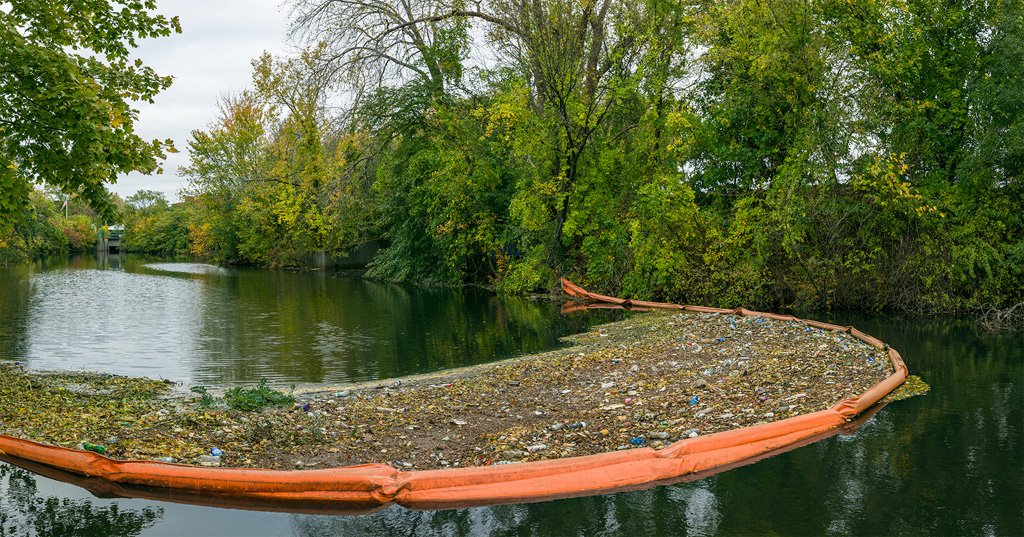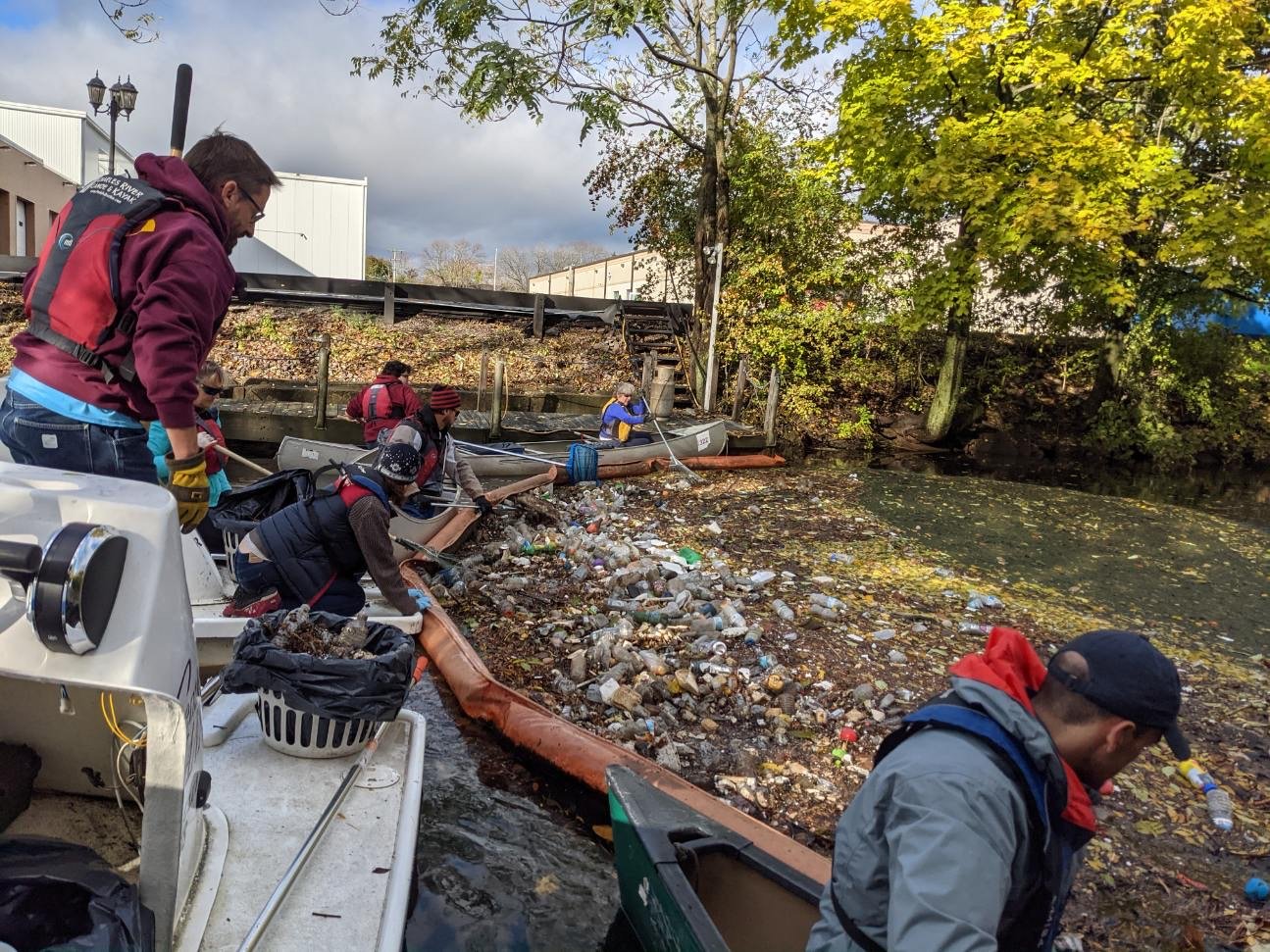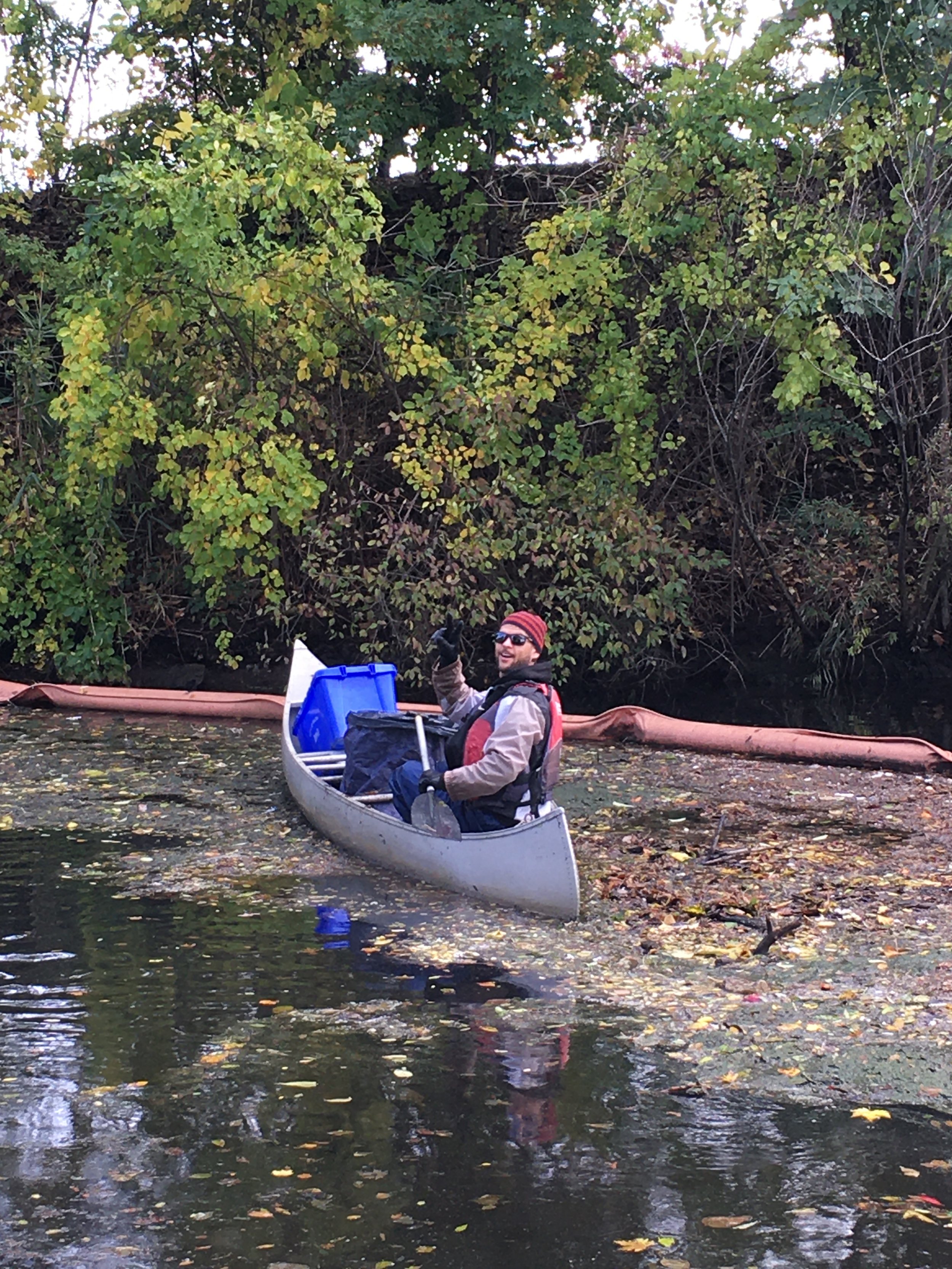Featuring Karen Buck, co-founder and president of Friends of the Malden River
A New Trash Trap is Installed in the Malden River
On November 18th, MyRWA, Friends of the Malden River, and our partners installed a new trash trap on the Malden River. Situated across the northern end of the river, this trash trap will catch and hold trash before it has a chance to float further down the Malden River and into the Mystic.
PC: David Mussina
“Most trash in the ocean comes from rivers, and this trash in the rivers comes from land,” said Sushant Bajracharya, Mystic River Watershed Association. “Through this trash trap we are having an impact locally, and globally.”
With its ability to store a high volume of trash, this trash trap is an upgrade from the trash boom that was previously in the Malden River. This improvement was funded in part by the North American Wetlands Conservation Act and is part of our ongoing work to reduce stormwater pollution and improve water quality in the watershed.
A Team Effort
PC: David Mussina
Installing the trash trap in the river was no small feat. We want to give our heartfelt thanks to these generous partners and community members who donated their time and equipment to make this project possible:
John Preotle Jr., John Spinella, Gilmar Segura & Mike McCarthy of River's Edge
Basil and Angelo Rigano, Victor, Jose, & Jesus of Riganos Towing Service
Joe Sallese Jr., Carmen Mastropietro, & Jamie Duplease of Joe’s Welding & Armor Door Inc.
Strategic Environmental Services
Special shoutout to Mayor Gary Christenson of the City of Malden for stopping by to show his support for the hard-working installation team and for his commitment to cleaning up trash!
Credit: Trillium Studios Film
Momentum on the Malden River:
In the guest blog below, Karen Buck, Friends of the Malden River, shares how this new Trash Trap fits into the overall story of the Malden River, and how a community came together to generate this momentum to improve the Malden River:
By Karen Buck
The Malden River’s Industrial History
One of the greatest ironies of the City of Malden is that many residents are unaware that they are proud owners of the Malden River. This gem has been hidden from sight for decades due to its industrial past.
The Malden River was part of an important waterway system within the lands of the Massachusett tribe and the Pawtucket Confederacy of Indigenous tribes. The watershed and its tributaries provided food, transportation networks, and opportunities for trading among the Pawtucket, Massachusett and Wampanoag peoples, and eventually with European colonists. The Malden River was mostly marshland until the mid-1600’s when the colonists started to fill in the tidelands for farming.
Beginning in the 1850’s the Malden section of the Malden River was channelized and industries lined its banks, walling off the river from public view. In 1885 Spot Pond Brook (the head of the Malden River) was systematically channelized above ground and was utilized as a transportation system within the city limits. By the turn of the 20th century, the Spot Pond Brook was channeled underground beneath downtown Malden. This work continued into the late 1950’s as its tributaries were also buried.
Map of the original Malden River, before channelization (pre-1850’s)
A worker sits above a section of the Malden River
Malden Residents Want a Cleaner River
In 2017, Malden residents participated in an Open Space and Recreation Survey. There were about 491 respondents. Overwhelmingly, the Malden River was highlighted as a priority among the surveyed residents as a viable and important investment for the city of Malden. The overwhelming number of responses (84.67%) was positive about focusing on obtaining more open space. The majority of the respondents, (84.67%), opted to create a continuous path along the Malden River. But, a large majority of these respondents also commented that they perceived the Malden River as “dirty”. The overwhelming amount of trash was a visible deterrent for public participation with the Malden River.
A Healing River
The industrial blighted riparian history has tainted the public opinion of the Malden River. Thanks to the federal Clean Water and Clean Air regulations, our urban waterways are healing; the Malden River is an example of a healing river. A thorough scientific study, The Malden River Public Health Risk Study, conducted by MIT Center for Environmental Health Sciences (CEHS), Mystic River Watershed Association, and Gradient Environmental Consultants concluded that the riverbed of the Malden River is safe for boating in dry weather. Why the need for dry weather for safe boating?
PC: Rich Whelan
One drawback for the health of all waterways are the storm water systems which drain into our waterways. During rain storms, street detritus including litter, motor fluids, pesticides, fertilizers, leaves, and sediments flow into the street storm drain systems and ultimately into our waterways. Harmful bacterial levels rise which creates an unhealthy environment for boating. The Daily Boating Advisory of MyRWA takes all factors into an algorithm and alerts us to safe or unsafe boating conditions on a daily basis.
Malden River sees the light of day (day lights) through two huge stormwater culverts 2.3 miles north of its confluence with the Mystic River. These culverts allow and illustrate the flow of stormwater trash into the Malden River and ultimately into the Mystic River and onwards. There arises two challenges: stop the pollution from entering our street storm drain systems and stop the flow of trash down stream.
As we work with the municipalities to reduce street pollution by implementing better maintenance plans or engineering models like the recently installed storm water trenches that capture harmful nutrient overloads, we can trap trash to prevent it from flowing downstream. Plastic trash travels quickly and far. It also breaks down into micro plastics (pieces under 5 cm) which permeate into our environment. It is imperative to stop the plastic waste from entering our waterways and dispose of it correctly.
A Trash Boom Yields Data & Stresses Importance of an Effective Containment System
In 2019, The Friends of the Malden River received a grant from the Massachusetts Environmental Trust to extract and assess the collection of trash from the trash boom installed by the Friends. This data would be used to educate the public and instigate municipal participation in reducing the flow of trash into the Malden River. The data of trash collected included: From July through the beginning of November of 2019, 506 single use plastic bottles, 581 plastic alcoholic nips, 37 pounds of dried polystyrene, and 184 pounds of other pollutants were removed from the trash boom. On October 5, 2019, a Malden River trash cleanup south of the boom included 614 single use plastic bottles, 395 plastic alcoholic nips, 20 pounds of dried polystyrene and 115 pounds of other pollutants. During the spring of 2020 (the boom was not installed due to pandemic delays), the Malden River Trash Challenge Network collected a total of 2185 single use bottles and 1606 alcoholic nips, in addition to large amounts of miscellaneous trash off of the Everett and Medford banks of the Malden River.
All of this trash data has underlined the importance of an effective containment system for the trash from traveling downstream. The initial trash boom stopped a percentage of the trash but presented different hurdles. The maintenance plan was volunteer based manual labor. During heavy rainfalls and wind, trash escaped the trash boom barrier.



The Malden River Today
This brings us to the recent installation of the new Trash Trap in the Malden River. Not only will this Trash Trap help reduce the amount of escaped trash floating downstream in the river, but it will also serve as an educational opportunity for the public to learn more about the problem of stormwater pollution in our watershed. We will install interpretative signage at the attention-grabbing Trash Trap.
These efforts will help sustain and raise the public opinion and use of the Malden River.Present day users, mostly rowers of Tufts University and Gentle Giant Rowing Club, have commented that the Malden River is less encumbered by trash and Paddle Boston customers have noted less trash in the Mystic River. We hope to continue making the Malden River a safe, healthy, and accessible natural space for all to enjoy!
For updates on the Malden River and our #TrashFreeMystic initiative, subscribe to our monthly newsletter and check out Friends of the Malden River’s website!











